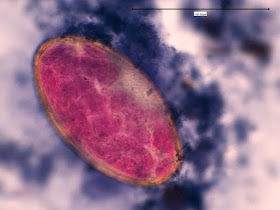Fasciola hepatica (Trematode –
Parasite)
Fasciola hepatica is commonly known as the sheep liver fluke and is a common parasite in
herbivores. With cosmopolitan
distribution, human infections have been reported in many parts of the world. Fasciola
hepatica is most frequently found in countries where sheep raising is
common, such as China, Taiwan, India, Indonesia and other parts of Asia.
Fasciola hepatica is responsible for the disease fascioliasis, also known as
fasciolopsiasis or simply, sheep liver fluke infection. The infection may have first been recognized
as early as 1379 when the effects were noticed between certain water plants and
the sheep that had eaten them. Fascioliasis
is considered a zoonotic disease (passed
from animals to man).
Symptoms: The infection may produce symptoms of biliary
obstruction and cholangitis. Symptoms
may include upper right quadrant pain, fever, chills and jaundice. Symptoms may depend on the worm burden and light
infections may be asymptomatic.
Life Cycle & Morphology:
Worms: The Fasciola
fluke is quite large and may measure as large as 3 cm by 1.5 cm in size. The anterior end of the worm (fluke) has a
distinctive cone shaped projection. The interior organs of the worm appear extensively
branched. The adult worms live in the
bile ducts of the liver and the gallbladder.
Eggs: The eggs (ova) are large (80-150 µm by about
60 -90 µm) and broadly elliptical in appearance. They are operuclated but the operculum is
rather small in relation to the egg and rather inconspicuous. The eggs are unembryonated when passed in the
feces. When passed into water, they
undergo embryonation and subsequently miracidia are hatched (usually in 1 – 2 weeks). Fasciola
hepatica requires an intermediate host for development, which in this case
is a freshwater snail (Lymnaea sp). The miracidia within the snail mature and
emerge as cercariae which then attach to aquatic vegetation (eg. watercress) where they undergo
encystation. Humans are infected by the
ingestion of uncooked aquatic vegetation on which the metacercariae are
encysted. The metacercariae excyst
(hatch) in the duodenum and migrate through the intestinal wall into the
peritoneal cavity. The larvae penetrate the
liver and wander through the parenchyma for up to 9 weeks. The larvae finally enter the bile ducts where
they mature and in about three to four months and begin to produce eggs, which
are ultimately passed out in the feces.
The adult worms may live for up to a year.
Diagnosis:
Diagnosis is made by the
detection of the characteristic eggs in the patient’s faeces. One problem in identification is that the
species Fasciolopsis buski produces
eggs which are almost indistinguishable from those produced by Fasciola hepatica. Life cycles of these two trematodes are very
similar. In some areas of the orient
where these two species overlap, the clinical evaluation of symptoms aids the
diagnosis of these faciolid eggs. The
size of the operculum opening may also assist in diagnosis where the Fasciola hepatica’s operculum is
larger than that of Fasciolopsis buski
(measurements to follow). Putting
pressure on the coverslip of a concentrated faecal specimen with the eraser end
of a pencil may be sufficient to cause the operculum to pop open and better
reveal itself. Molecular methods may
provide a definitive identification.
Fasciola hepatica egg in faecal concentrate. Bile-stained shell and inconspicuous operculum.
Egg measures 151 µm by 75 µm. (DMD-108)
Fasciola hepatica egg with Iron Heamatoxylin stain. (DMD-108)
Fasciola hepatica egg showing the operculum (OP). Measurement reads 28.82 µm. (DMD-108)
* * *




No comments:
Post a Comment